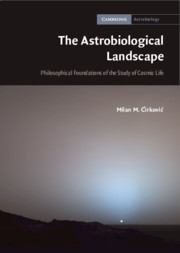Refine listing
Actions for selected content:
16950 results
2 - Telescopes
-
- Book:
- Measuring the Universe
- Published online:
- 05 November 2012
- Print publication:
- 12 July 2012, pp 25-57
-
- Chapter
- Export citation
Preface
-
- Book:
- Modern Statistical Methods for Astronomy
- Published online:
- 05 November 2012
- Print publication:
- 12 July 2012, pp xv-xviii
-
- Chapter
- Export citation
4 - Hadronic processes and neutrino emissions
-
- Book:
- Relativistic Astrophysics of the Transient Universe
- Published online:
- 05 August 2012
- Print publication:
- 05 July 2012, pp 110-122
-
- Chapter
- Export citation

The Astrobiological Landscape
- Philosophical Foundations of the Study of Cosmic Life
-
- Published online:
- 05 July 2012
- Print publication:
- 21 June 2012
6 - Winds and jets
-
- Book:
- Relativistic Astrophysics of the Transient Universe
- Published online:
- 05 August 2012
- Print publication:
- 05 July 2012, pp 135-152
-
- Chapter
- Export citation
7 - Relativistic shock waves
-
- Book:
- Relativistic Astrophysics of the Transient Universe
- Published online:
- 05 August 2012
- Print publication:
- 05 July 2012, pp 153-182
-
- Chapter
- Export citation
8 - Relativistic blast waves
-
- Book:
- Relativistic Astrophysics of the Transient Universe
- Published online:
- 05 August 2012
- Print publication:
- 05 July 2012, pp 183-205
-
- Chapter
- Export citation
Quotation acknowledgements
-
- Book:
- Relativistic Astrophysics of the Transient Universe
- Published online:
- 05 August 2012
- Print publication:
- 05 July 2012, pp xix-xx
-
- Chapter
- Export citation
References
-
- Book:
- Relativistic Astrophysics of the Transient Universe
- Published online:
- 05 August 2012
- Print publication:
- 05 July 2012, pp 308-323
-
- Chapter
- Export citation
Appendix C - Relaxation limited evaporation
-
- Book:
- Relativistic Astrophysics of the Transient Universe
- Published online:
- 05 August 2012
- Print publication:
- 05 July 2012, pp 300-304
-
- Chapter
- Export citation
3 - Curved spacetime and gravitational waves
-
- Book:
- Relativistic Astrophysics of the Transient Universe
- Published online:
- 05 August 2012
- Print publication:
- 05 July 2012, pp 84-109
-
- Chapter
- Export citation
Notation
-
- Book:
- Relativistic Astrophysics of the Transient Universe
- Published online:
- 05 August 2012
- Print publication:
- 05 July 2012, pp xvii-xviii
-
- Chapter
- Export citation
Contents
-
- Book:
- Relativistic Astrophysics of the Transient Universe
- Published online:
- 05 August 2012
- Print publication:
- 05 July 2012, pp vii-x
-
- Chapter
- Export citation
Index
-
- Book:
- Relativistic Astrophysics of the Transient Universe
- Published online:
- 05 August 2012
- Print publication:
- 05 July 2012, pp 324-333
-
- Chapter
- Export citation
5 - Relativistic fluid dynamics
-
- Book:
- Relativistic Astrophysics of the Transient Universe
- Published online:
- 05 August 2012
- Print publication:
- 05 July 2012, pp 123-134
-
- Chapter
- Export citation
Appendix B - Cosmological event rates
-
- Book:
- Relativistic Astrophysics of the Transient Universe
- Published online:
- 05 August 2012
- Print publication:
- 05 July 2012, pp 296-299
-
- Chapter
- Export citation
12 - Searching for long bursts in gravitational waves
-
- Book:
- Relativistic Astrophysics of the Transient Universe
- Published online:
- 05 August 2012
- Print publication:
- 05 July 2012, pp 271-286
-
- Chapter
- Export citation
10 - Entropic attraction in black hole binaries
-
- Book:
- Relativistic Astrophysics of the Transient Universe
- Published online:
- 05 August 2012
- Print publication:
- 05 July 2012, pp 227-251
-
- Chapter
- Export citation
Frontmatter
-
- Book:
- Relativistic Astrophysics of the Transient Universe
- Published online:
- 05 August 2012
- Print publication:
- 05 July 2012, pp i-vi
-
- Chapter
- Export citation
Preface
-
- Book:
- Relativistic Astrophysics of the Transient Universe
- Published online:
- 05 August 2012
- Print publication:
- 05 July 2012, pp xiii-xvi
-
- Chapter
- Export citation
